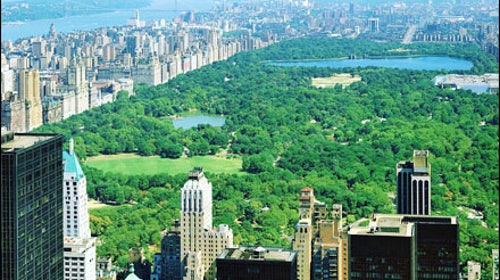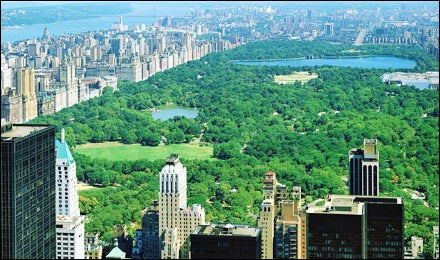ON A 105-DEGREE New York City afternoon, I hop on the #4 train and head north—past a good friend’s one–bedroom on the Upper East Side, past a Harlem hangout that really kicks in the wee hours, and, continuing on aboveground, past Yankee Stadium in the Bronx. Until a few months ago, my only experience with the fourth borough was hobbling through it during the New York City Marathon: In the poverty–stricken neighborhood of Mott Haven, two women held up a homemade sign that read, WELCOME TO THE BRONX. THAT’S RIGHT, YOU BETTER RUN. Ha–ha, I thought, not knowing that “SoBro,” as desperate realtors try to call it, remains one of the best places in America to get shot. I don’t want to get shot. I just want to see a beaver.
Exiting at Bedford Park Boulevard, in the north Bronx, I stroll eight blocks southeast, past drivers futzing under the opened hoods of broken–down cars. I cross Kazimiroff Boulevard, a bustling four–lane, and enter the New York Botanical Garden. Its 250 shady acres, currently showcasing a collection of Henry Moore sculptures, border the Bronx Zoo to the south and lie just northeast of the shattered–glass ghetto of East Tremont. Inside the gate, the temperature immediately drops ten degrees.
Bob Heinisch, the well–dressed VP for site operations, greets me. “Do you need any provisions?” he asks as we hop into his golf cart and zip to the banks of the Bronx River, south of a low waterfall, in the Forest area of old native trees.
“OK,” he says, vaguely gesturing that we’ve arrived at the spot while simultaneously checking his BlackBerry.
I step out onto the riverside path. The jungly little valley looks as good as any for a wayward beaver. I cowboy up onto the mossy back of an American elm that corkscrews out over the water. Then, quietly, I start calling. “Hey, buddy,” I say. “C’mere, José.”
MY EDITORS WANTED a wildlife column, and I had a bazillion ideas, from tracking the yeti in Nepal to following a migration of white–eared antelopes in Sudan. They said, “No. How about your new backyard?”
So, in early spring, I began reappraising my adopted home city, the 300 square miles of concrete and steel that Kurt Vonnegut once called Skyscraper National Park. I quickly came to see that the metropolis, which claims to be world capital of everything from finance to sneaker collecting, was also one wild kingdom. Leslie Day’s 2007 book Field Guide to the Natural World of New York City went so far as to say that New York is quite possibly the most biologically diverse big city in temperate America. This is no hollow boast. Suburban sprawl is dislocating wildlife, and NYC’s healthy waterways, treed streets, 500 miles of coastline, and 30,000 acres of well-maintained parks are proving to be inviting habitat.
There are, of course, uncountable thousands of ordinary animals—bats, skunks, hipster goons on fixed–gear bikes—but there are also plenty of surprises. Peregrine falcons nest in the eaves of high rise buildings, supposedly more per square mile than almost anywhere else on earth. Harbor seals bask near the Coney Island boardwalk. Bears and moose have pawed at the city lines, coyotes and deer have wandered into Manhattan, dolphins and a Florida manatee have summered in the East River, and all sorts of reintroduced critters are doing well. Hedda Gobbler, a wild turkey that lives in Harlem’s Morningside Park, is practically a tourist attraction.
Sounds exciting, but my first urban safaris were decidedly ho–hum. I failed at birding in Central Park (seeing nowhere near the 100 to 150 species that an expert can log) and grew bored with “mothing,” hanging with three charming kooks who ogle drab lepidoptera in Central Park’s Shakespeare Garden (with a black light—wow). Then I heard about José.
Three hundred years ago, New York was lousy with beavers. “You could walk across rivers without getting your feet wet,” said Damian Griffin, education director for the Bronx River Alliance. But fur trappers wiped out the local population, and it wasn’t until 2007 that an actual beaver was positively identified, after Bronx Zoo PR representative Stephen Sautner stumbled upon José’s lodge, adjacent to the zoo’s Bronx River parkinglot. “It was in the zoo!” Sautner told me. “Twenty–five yards from where hundreds of animal experts park, and no one had seen it.”
Sautner and staff named the beaver after the borough’s green–minded congressman, José Serrano, and sent out a press release heralding the species’s return as an emblem of New York’s ecological health. Never mind that no one knew whether José’s appearance was a freak accident or evidence of a returning, viable population—he made headlines. The New York Times: AFTER 200 YEARS, A BEAVER IS BACK IN NEW YORK CITY. New York Daily News: WELL, WE’LL BE DAMMED. Not long after, a flood destroyed the lodge and José went missing.
Last April, sweeping the East River around the UN building in preparation for Pope Benedict XVI’s visit, the New York harbor patrol found a suspicious “dark foreign object” that turned out to be a beaver sick with pneumonia. The animal was raced north to a Castor canadensis specialist in Utica, but it was too late. Some feared the worst: that José had been flushed downstream, all the way to Midtown. But others continued to see gnawed stumps around the Botanical Garden, and some claimed to have actually seen José themselves. No one had photographic proof, though.
That was when I became obsessed with the elusive little fur ball.
FROM MY TREE, I can almost make out José’s rebuilt lodge, a bankside mound of twigs roughly three feet high and concealed under small trees, along with a few of the saplings he’s felled. (So far, the garden’s caretakers don’t mind.)
Nothing really happens for three hours. Daylight twinkles through the leafy canopy. Songbirds chirp like R2–D2. The noise of cars on Fordham Road, only a couple hundred yards away, plays a low B–flat, cut through by the farting of an 18–wheeler’s Jake Brake. Squirrels wrestle and tumble through the dried oak leaves. Four mallards with emerald–green heads paddle downstream in peloton formation. It’s not exactly Walden, but in a city with one resident per five square feet, your own tree, even one full of ants, feels luxurious.
Experts warned that I wouldn’t be able to discern much. Beavers must be trapped to determine their age and sex, a trauma–inducing tactic best avoided. As for where José came from, they can only guess. Most likely he was beavering away upstate near Valhalla when a flood washed him some 18 miles downstream. Now he’s alone in the Bronx.
At dusk, just as I’m beginning to lose faith, he appears.
Hooray!
He looks healthy, almost gordo. Forty pounds, I’d guess. A streak of khaki fur under his syrupy eyes darkens to chestnut on his sleek, half-submerged back. His tail looks like a fraternity paddle, and it isn’t chewed up from what could have been a wild ride through the Bronx River’s Kensico Dam. City life appears to be treating him well.
He lazily munches branches, typewriter style, scratches his funnel–shaped ear with his paw, then drifts away as I take pictures in the fading light. A canvas satchel of oranges floats by. (Later, I’ll learn that the oranges were set adrift upstream as part of a ritual performed by practitioners of Santería, a fusion of tribal West African and Christian beliefs.) José taps the fruit with his glistening nose, then grabs a few twigs from a logjam, kick–turns, and dives toward the lodge, trailing leaves on the surface.
His appearance brings the river to life. A snapping turtle with vicious claws run–walks for cover in murkier water, apparently causing a carp the size of a child to breach. From the cover of creeping vines, this flushes out a baby beaver?! He’s right underfoot, small enough to fit in a shoe box, same nose and ears as José’s but with a thin, scaly tail. Spooked, he paddles for the opposite bank, tacks upstream, then down, and then disappears.
Hmmm. Maybe the scientists are wrong. Maybe José has found a mate.
AT HOME, MY PHOTOS confirm that the big beaver is definitely José, and a hasty Google search for “young beaver” (bad word choice) reveals that the other rodent is not an adolescent beaver but an adult muskrat. I start to wonder if José and the muskrat aren’t, well . . . nah, they probably just share the same bathwater. My probing turns up no examples of beavers getting intimate with their rodent cousins, so I devise my own plan: Borrow night-vision binoculars. Stake out the lodge.
At 4:30 p.m. on Wednesday, June 4, Critter Watch ’08 begins. It’s cooler but, again, no José.
A red–winged blackbird swoops to perch on a droopy branch. A woodpecker soundsexhausted by his own jackhammering. The sky fades from denim to peach to charcoal. For four hours, exceptionally unhurried and underwhelmed, I can’t help but feel that everything is downright portentous—even the quilt of fireflies over the river, which seems to offer commentary on the aim of life itself. Do not conserve your energy, the lightning bugs say; set your very being ablaze!
Still no José. I cross the street to McDonald’s and order a Southwest Salad with Chicken. There I strike up a conversation with a neighboring table of mothers and daughters eating sundaes. They’re friendly, but a little taken aback. It’s not every night you run into an extremely outgoing white guy in the Bronx asking questions about urban fauna. They say the only wildlife they know of are “cucarachas.”
“What, you like Crocodile Dundee?” a high–school boy at a nearby booth wants to know.
I explain that I’m a journalist planning to spend the night observing the historic beaver.
“Jeff Irwin?” a second boy asks.
“Oh, snap!” a girl says.
Back at the river, the reflection of an airplane lurches forward on little waves—a creature is stirring—and I turn on the Yukon Advanced Optics Digital Night Vision Ranger 5×42 binoculars. The oily scene transforms into a grainy black-and-white photo, and there, near a raft of brush caught midstream after last night’s windstorm, I glass José. Devil José. Seen through the binoculars, his fur has the coarse lines of a woodblock print and his eyes glow bright white. He U–boats toward me until all I can see is his two burning orbs. I rise to tiptoe for shore and he slaps his tail down with a deafening crack—kaploosh! I fall to the tree, hugging it with arms and legs.
Sometime after 1 a.m., I unroll my Calvin Klein bedsheet in the ornamental–conifers section of the garden, amid the wailing of sirens. Muskrat love? What was I thinking?
AT ROUGHLY 5 A.M., José is at the opposite bank. After a few minutes burrowing into the dark mud, he beelines it for the lodge, followed by the muskrat, or Sebastien, as I’ve come to call him, whose head is covered in leafy greens. Sebastien and José are not seen all morning.
Scandalous!
There can be no doubt now that Sebastien is shacking up with José.
Back at my apartment, I make a few calls. It turns out I am not the only one to notice the partners. Julie Larsen Maher, staff photographer with the Wildlife Conservation Society, has observed José and what looked like a muskrat. She even has a digital pic, slightly blurry and taken from far away, which she e-mails me. Like flood victims, they are perched at the tippy top of the original lodge as the rising brown waters threaten to wash away their home. It’s not exactly the photo I imagined—a close–up of José and Sebastien climbing out of a limo on the Côte d’Azur after–hours—but it does suggest a beaverly imbroglio.
Darrin Lunde also knows about José. He’s the collections manager for the department of mammalogy at the American Museum of Natural History, and he’s done extensive research for a book about beavers.
“Could a beaver and a muskrat live together?” I ask.
“Sure, that’s not uncommon,” he says. “They’re well known to share lodges.”
“And could they ” I stutter, struggling to find the appropriate scientific term.
“God, no!” he replies. “They’re completely different genera.”
That’s cool, I guess. New York City has plenty of space for all kinds of breeds.


